Wistron NeWeb BQ12AB Notebook Personal Computer User Manual TM430 e
Wistron NeWeb Corporation Notebook Personal Computer TM430 e
Contents
- 1. for module
- 2. notebook part 1
- 3. notebbok part 2
- 4. notebook part 2
notebook part 1
TravelMate 430 Series
User’s Guide
Model
BQ12
Changes may be made periodically to the information in this publication without obligation
to notify any person of such revision or changes. Such changes will be incorporated in new
editions of this manual or supplementary documents and publications. This company makes
no representations or warranties, either expressed or implied, with respect to the contents
hereof and specifically disclaims the implied warranties of merchantability or fitness for a
particular purpose.
Record the model number, serial number, purchase date, and place of purchase information in
the space provided below. The serial number and model number are recorded on the label
affixed to your computer. All correspondence concerning your unit should include the serial
number, model number, and purchase information.
No part of this publication may be reproduced, stored in a retrieval system, or transmitted, in
any form or by any means, electronic, mechanical, photocopy, recording, or otherwise,
without the prior written permission of Acer Incorporated.
Model number : _________________________________
Serial number: ___________________________________
Purchase date: ___________________________________
Place of purchase: ________________________________
Copyright © 2003 Acer Incorporated.
All Rights Reserved.
TravelMate 430 Series Notebook Computer User's Guide
Original Issue: January 2003
TravelMate 430 series Notebook computer
Acer and the Acer logo are registered trademarks of Acer Incorporated. Other company's
product names or trademarks are used herein for identification purposes only and belong to
their respective companies.
1
Federal Communication Commission Interference Statement
This equipment has been tested and found to comply with the limits for a Class B
digital device, pursuant to Part 15 of the FCC Rules. These limits are designed to
provide reasonable protection against harmful interference in a residential installation.
This equipment generates, uses and can radiate radio frequency energy and, if not
installed and used in accordance with the instructions, may cause harmful interference
to radio communications. However, there is no guarantee that interference will not
occur in a particular installation. If this equipment does cause harmful interference to
radio or television reception, which can be determined by turning the equipment off
and on, the user is encouraged to try to correct the interference by one of the
following measures:
- Reorient or relocate the receiving antenna.
- Increase the separation between the equipment and receiver.
- Connect the equipment into an outlet on a circuit different from that to
which the receiver is connected.
- Consult the dealer or an experienced radio/TV technician for help.
FCC Caution: To assure continued compliance, (example - use only shielded
interface cables when connecting to computer or peripheral devices) any
changes or modifications not expressly approved by the party responsible for
compliance could void the user's authority to operate this equipment.
This device complies with Part 15 of the FCC Rules. Operation is subject to the
following two conditions:
(1) This device may not cause harmful interference, and
(2) This device must accept any interference received, including interference
that may cause undesired operation.
IMPORTANT NOTE:
FCC Radiation Exposure Statement:
This equipment complies with FCC radiation exposure limits set forth for an
uncontrolled environment. This transmitter must not be co-located or operating
in conjunction with any other antenna or transmitter.
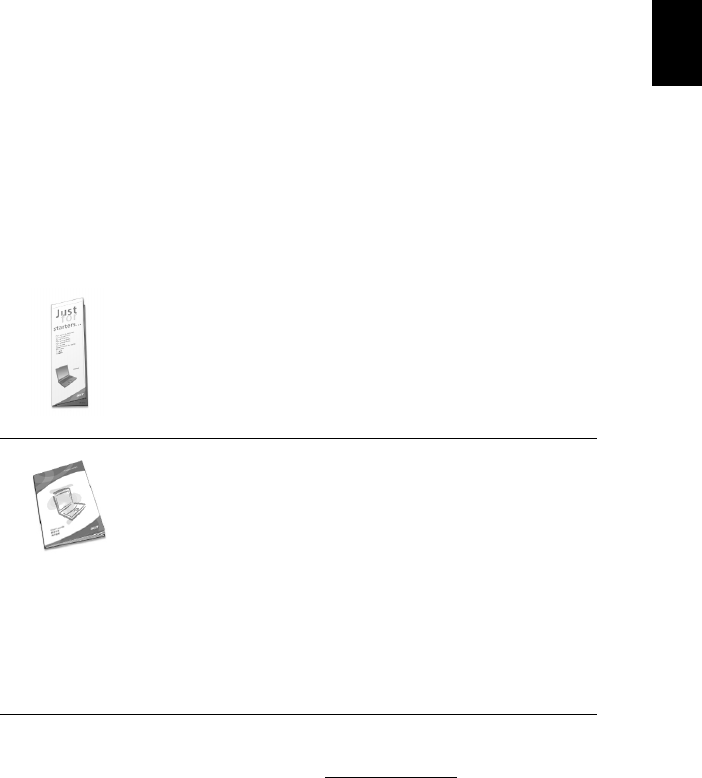
iii
English
First things first
We would like to thank you for making the TravelMate series of
notebook computers your choice for your mobile computing needs.
We hope you will be happy with your TravelMate as much as we
enjoyed making it for you.
Your guides
To help you use your TravelMate, we have designed a set of guides:
For more information about our products, services, and support
information, please visit our Web site (global.acer.com).
First off, the Just for Starters... poster helps you get
started with setting up your computer.
This User’s Guide introduces you to the many ways your
computer can help you be more productive. This guide
provides clear and concise information about the computer,
so read it thoroughly.
If you ever need to print out a copy, this User’s guide is also
available in PDF (Portable Document Format). Follow these
steps:
1 Click on Start, Programs, AcerSystem.
2 Click on AcerSystem User’s Guide.
Note: Viewing the file requires Adobe Acrobat Reader
installed. For instructions on how to use Adobe Acrobat
Reader, access the Help menu.
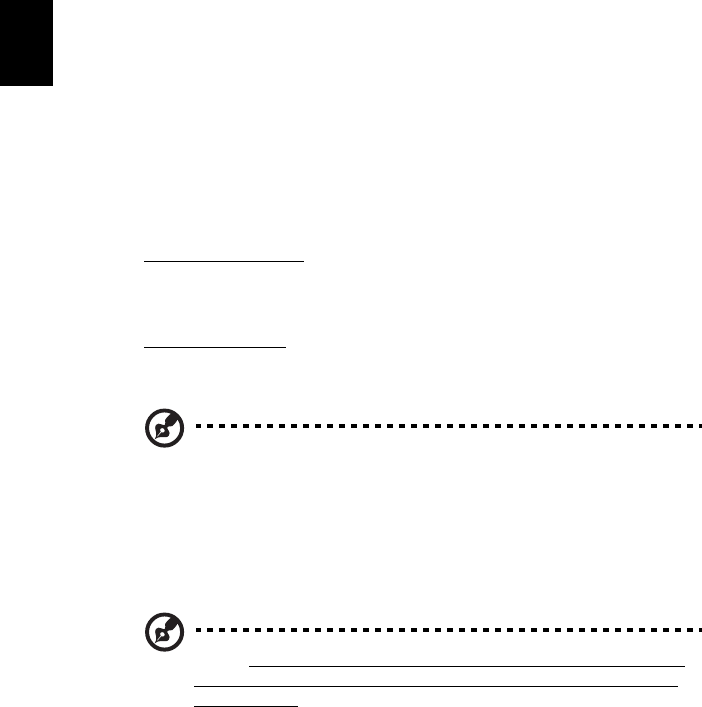
iv
English
Basic care and tips for using your computer
Turning your computer on and off
To turn on the computer, simply press the power button - the leftmost
button above the keybaord of your TravelMate. See page 3 for the
exact location of the power button.
To turn the power off, do any of the following:
•Use the Windows shutdown command
For Windows 2000: Click on Start, Shut Down..., and select Shut
down; then click on OK.
- or -
For Windows XP: Click on Start, Tur n off Computer; then click
Turn Off.
•Use the power switch
Note: You can also use the power switch to perform power
management functions. See Windows help for more information.
•Use the customized functions for power management
You can also shut down the computer by closing the display cover,
or by pressing the sleep hot key (Fn-F4). See “Hot keys” on page
15.
Note: If you cannot power off the computer normally, press and
hold the power switch for more than four seconds to shut down
the computer. If you turn off the computer and want to turn it on
again, wait at least two seconds before powering up.
Taking care of your computer
Your computer will serve you well if you take care of it.
•Do not expose the computer to direct sunlight. Do not place it
near sources of heat, such as a radiator.
•Do not expose the computer to temperatures below 0ºC (32ºF) or
above 50ºC (122ºF).
•Do not subject the computer to magnetic fields.

v
English
•Do not expose the computer to rain or moisture.
•Do not spill water or any liquid on the computer.
•Do not subject the computer to heavy shock and vibration.
•Do not expose the computer to dust and dirt.
•Never place objects on top of the computer to avoid damaging the
computer.
•Do not slam the computer display when you close it.
•Never place the computer on uneven surfaces.
Taking care of your AC adapter
Here are some ways to take care of your AC adapter:
•Do not connect the adapter to any other device.
•Do not step on the power cord or place heavy objects on top of it.
Carefully route the power cord and any cables away from personal
traffic.
•When unplugging the power cord, do not pull on the cord itself
but pull on the plug.
•The total ampere ratings of the equipment plugged in should not
exceed the ampere rating of the cord if you are using an extension
cord. Also, the total current rating of all equipment plugged into
a single wall outlet should not exceed the fuse rating.
Taking care of your battery pack
Here are some ways to take care of your battery pack:
•Use only batteries of the same kind as replacements. Turn the
power off before removing or replacing batteries.
•Do not tamper with batteries. Keep them away from children.
•Dispose of used batteries according to local regulations. Recycle if
at all possible.
Cleaning and servicing
When cleaning the computer, follow these steps:
1Power off the computer and remove the battery pack.
2Disconnect the AC adapter.

vi
English
3Use a soft cloth moistened with water. Do not use liquid or
aerosol cleaners.
4To clean the display screen, use an LCD cleaning kit.
If any of the following occurs:
•The computer has been dropped or the body has been damaged.
•Liquid has been spilled into the product.
•The computer does not operate normally.
Please refer to "Troubleshooting my computer" on page 47.
Contents
First things first iii
Your guides iii
Basic care and tips for using your computer iv
1 Getting to know your TravelMate 1
A TravelMate tour 3
Front view 3
Left view 5
Right view 6
Rear view 7
Bottom view 8
Features 9
Indicators 11
Using the keyboard 12
Special keys 12
Touchpad 20
Touchpad basics 20
Storage 22
Hard disk 22
Optical drive 22
Using software 23
Audio 24
Adjusting the volume 24
Using the Audio DJ feature 25
Power management 26
Moving around with your TravelMate 27
Disconnecting from the desktop 27
Moving around 27
Taking the computer home 28
Traveling with the computer 30
Traveling internationally with the computer 30
Securing your computer 32
Using a computer security lock 32
Using passwords 32
2 Customizing my computer 35
Expanding through options 37
Connectivity options 37
Upgrade options 41
Using system utilities 43
Notebook Manager 43
Launch Manager 44

viii
BIOS Utility 44
3 Troubleshooting my computer 47
Frequently-asked questions 49
Requesting service 52
International Traveler’s Warranty (ITW) 52
Before you call 53
Appendix A Specifications 55
Appendix B Notices 61
Index 69
English

1 Getting to know your
TravelMate

Your TravelMate computer combines high-
performance, versatility, power
management features and multimedia
capabilities with a unique style and
ergonomic design. Work with unmatched
productivity and reliability with your new
power computing partner.
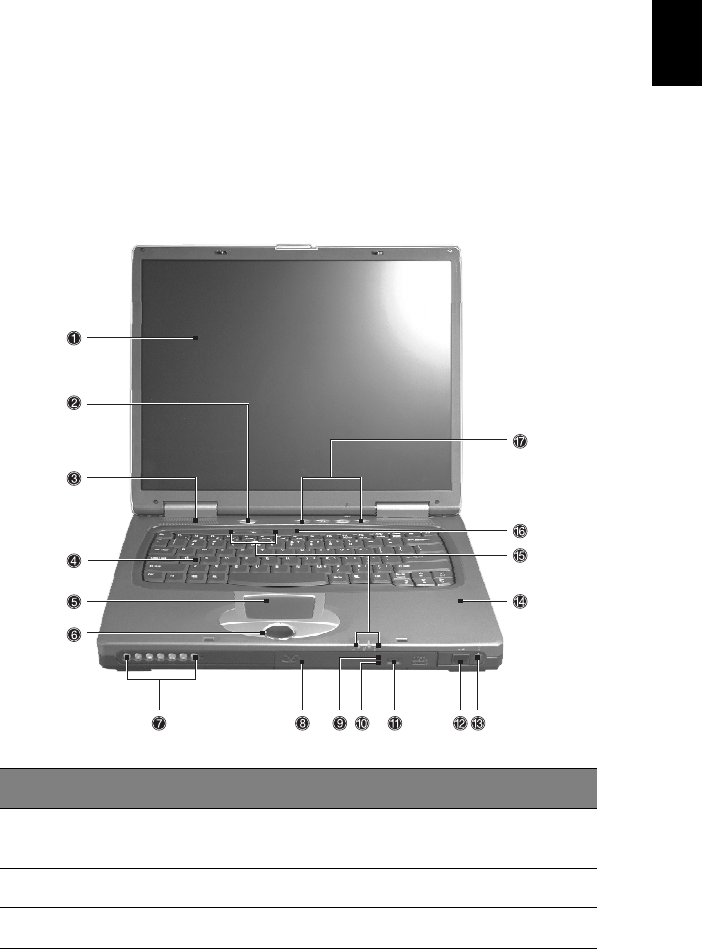
3
English
A TravelMate tour
After setting up your computer as illustrated in the Just for
Starters... poster, let us show you around your new TravelMate
computer.
Front view
#Item Description
1 Display screen Also called LCD (liquid-crystal display),
displays computer output.
2 Power Button Turns on the computer power.
3 Speakers Outputs sound.
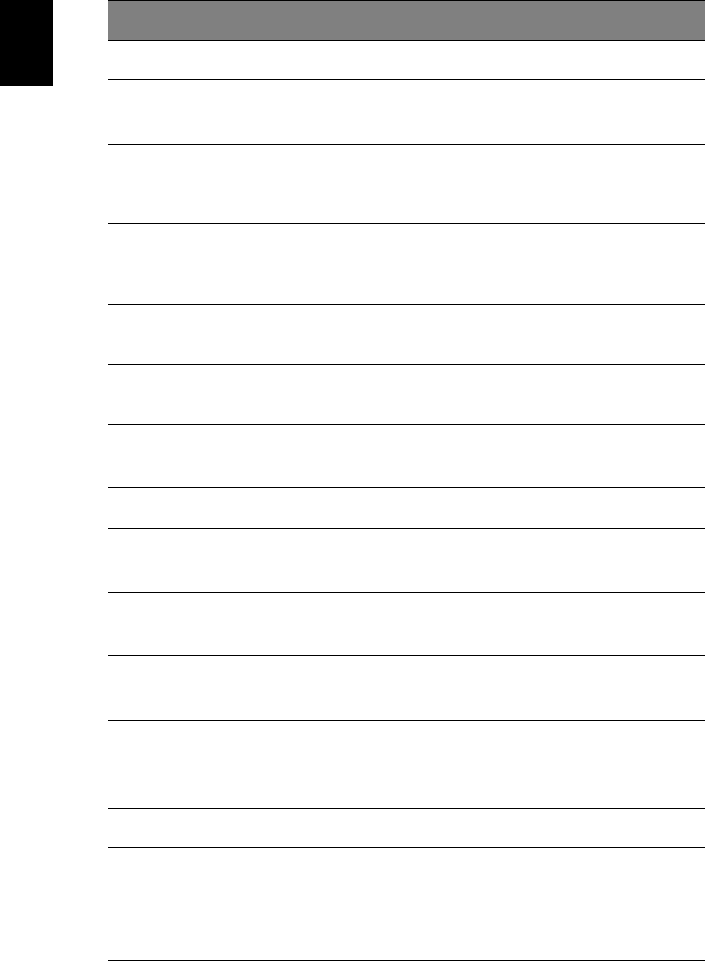
1 Getting to know your TravelMate
4
English
4 Keyboard Inputs data into your computer.
5 Touchpad Touch-sensitive pointing device which
functions like a computer mouse.
6 Click buttons (left,
center and right)
The left and right buttons function like the
left and right mouse buttons; the center
button serves as a 4-way scroll button.
7 Audio DJ controls
and indicators
Button and indicators for the Audio DJ
function. For more information, see “Using
the Audio DJ feature” on page 25.
8 Optical drive Houses an optical drive module (CD-ROM ,
DVD-ROM or DVD/CD-RW combo drive).
9 Optical drive
indicator
Lights up when the optical drive is active.
10 Emergency eject slot Ejects the drive tray when the computer is
turned off. See page 51 for more details.
11 Eject button Ejects the drive tray.
12 Infrared port Interfaces with infrared devices (e.g.,
infrared PDA, IR-aware computer).
13 Wireless networking
/ Bluetooth button
Enables or disables the wireless networking
/ Bluetooth(optional) feature.
14 Palmrest Comfortable support area for your hands
when you use the computer.
15 Status indicators LEDs (light-emitting diode) that turn on and
off to show the status of the computer, its
functions and components.
16 Microphone Inputs sounds and voices into your computer.
17 Launch keys Special keys for launching internet browser,
email program and frequently used
programs. See “Launch Keys” on page 18 for
more details.
#Item Description
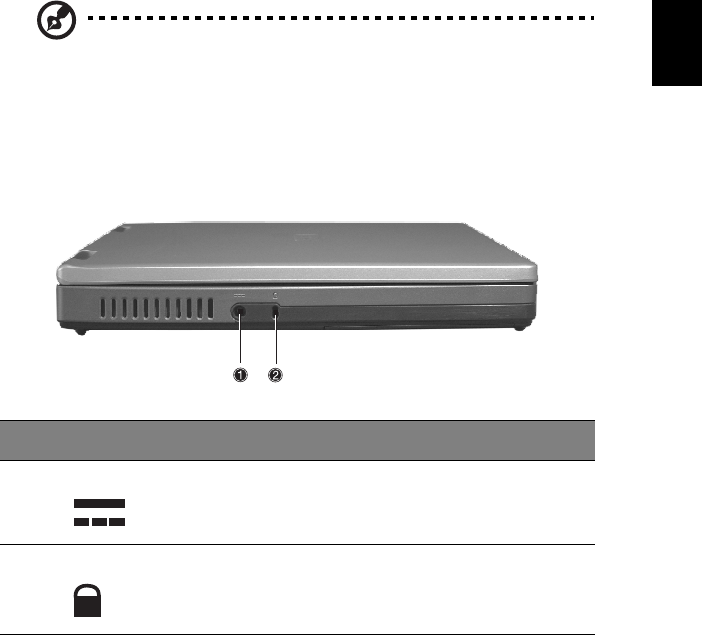
5
English
Note: The positions of the Optical drive indicator, eject button and
emergency eject hole may differ depending on the optical drive
module installed.
Left view
#Item Description
1 Power jack Connects to an AC adapter.
2 Security keylock Connects to a Kensington-compatible
computer security lock.
K
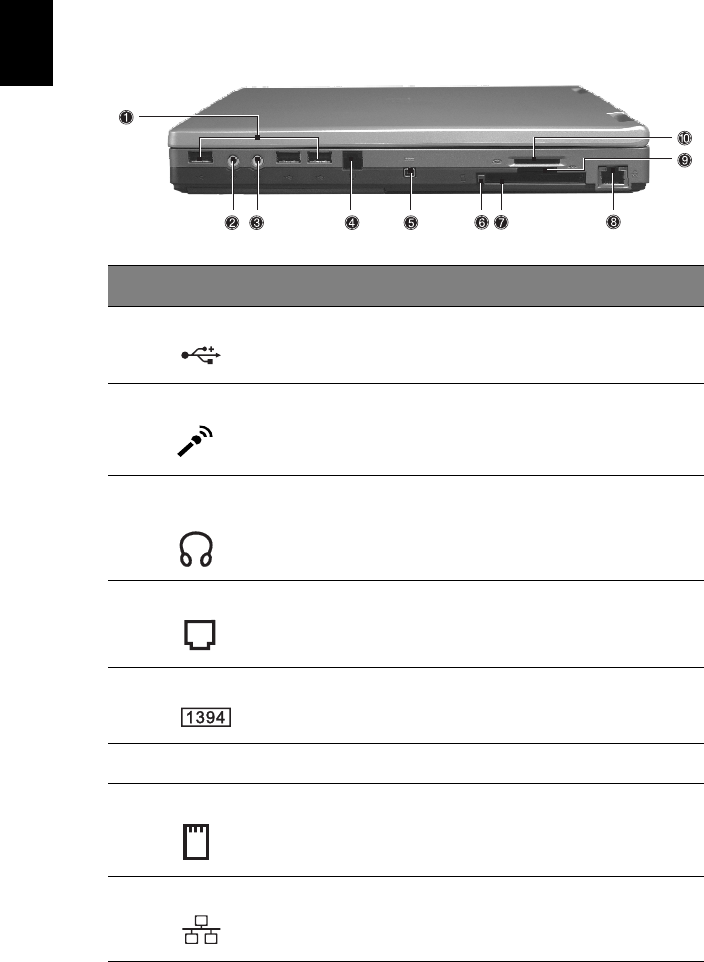
1 Getting to know your TravelMate
6
English
Right view
#Item Description
1 USB port Connects to Universal Serial Bus devices
(e.g.,USB mouse, USB camera).
2 Line-in/Mic-in jack Accepts audio line-in devices (e.g., audio CD
player, stereo walkman). Selection is through
the OS Windows mixer.
3 Speaker/
Headphone-out jack
Connects to audio line-out devices
(e.g.,speakers, headphones).
4 Modem jack Connects to a phone line.
5 IEEE 1394 port Connects to an IEEE 1394 device.
6 PC card eject button Ejects the PC card from the slot.
7 PC card slots Accepts one type II PC cards.
8 Network jack Connects to an Ethernet 10/100-based
network.
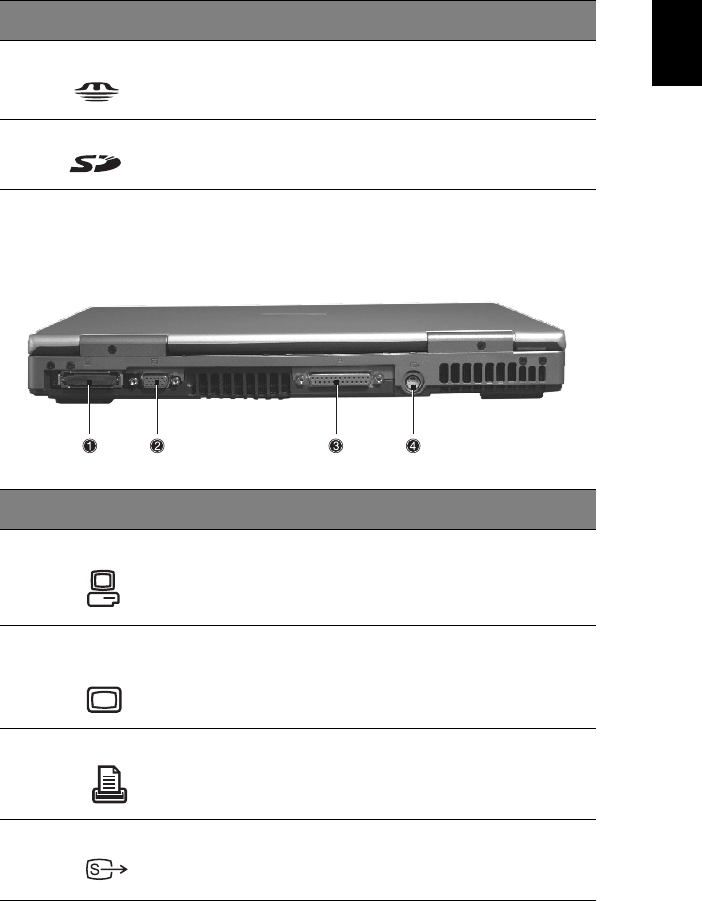
7
English
Rear view
9 Memory stick slot Accepts memory sticks.
10 SD/MMC slot Accepts SD or MMC cards.
#Item Description
1 Expansion port I/O replicator or EasyPort expansion devices.
2 External display
port
Connects to a display device (e.g., external
monitor, LCD projector).
3 Parallel port
Connects to a parallel device (e.g., parallel
printer).
4 S-video Connects to a television or display device
with S-video input.
#Item Description
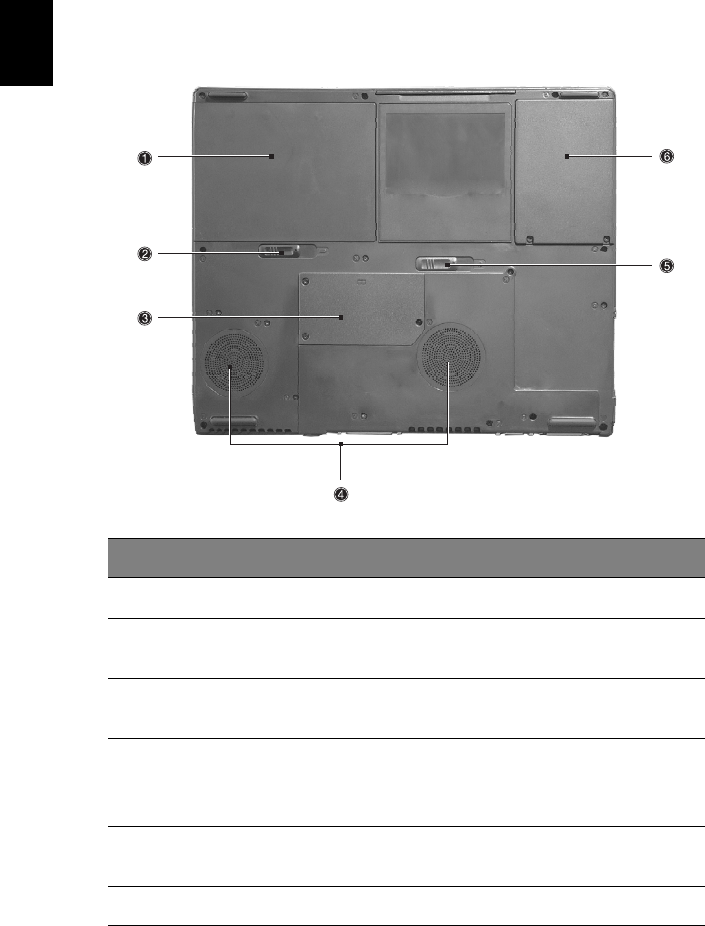
1 Getting to know your TravelMate
8
English
Bottom view
#Item Description
1 Battery bay Houses the computer's battery pack.
2 Battery release latch Unlatches the battery to remove the
battery pack.
3Memory
compartment
Houses the computer's main memory.
4 Cooling fans Helps keep the computer cool.
Note: Don't cover or obstruct the opening
of the fan.
5 AcerMedia drive bay
release latch
Unlatches the AcerMedia bay to remove
the optical diskette drive
6 Hard disk bay Houses the computer's hard disk.

9
English
Features
Below is a brief summary of the computer’s many features:
Performance
•Intel® Desktop P4P CPU with packing mPGA 478 package
•PC2100 DDR SDRAM, Maximum memory up 2GB (with two
1024MB SODIMM when available )
•Internal optical drive (swappable with optional drive)
•Removable PCI Bus Master Enhanced IDE hard disk
•Li-lon battery pack
•Power management system with ACPI (Advanced Configuration
Power Interface)
Display
•Thin-Film Transistor (TFT) liquid crystal display (LCD) displaying 32-
bit high true color up to 1024 x 768 eXtended Graphics Array
(XGA) resolution for 14”/15”. For some 15” models upto1400 x
1050 Super eXtended Graphics Array+ (SXGA+) .
•3D capabilities
•Simultaneous LCD and CRT display support
•S-video for output to a television or display device that supports S-
video input
•"Automatic LCD dim" feature that automatically decides the best
settings for your display and conserves power
•Dual display capability
Multimedia
•Realtek ALC202 AC’97 Codec audio
•Built-in dual speakers
•Built-in microphone
•High-speed optical drive
•Direct CD Player

1 Getting to know your TravelMate
10
English
Connectivity
•High-speed fax/data modem port
•Ethernet/Fast Ethernet port
•3 USB 2.0 (Universal Serial Bus) ports
•IEEE 1394 port
•SD/MMC memory slot
•Memory stick slot
•Acer EasyPort port replicator
•Wireless LAN ready (specification varies depending on models)
•Bluetooth ready (specification varies depending on models)
Human-centric design and ergonomics
•4-way scroll button
•Sleek, smooth and stylish design
•Acer FinTouch full-sized curved keyboard
•Ergonomically-centered touchpad pointing device
Expansion
•One type II CardBus PC Card slots
•Upgradeable memory
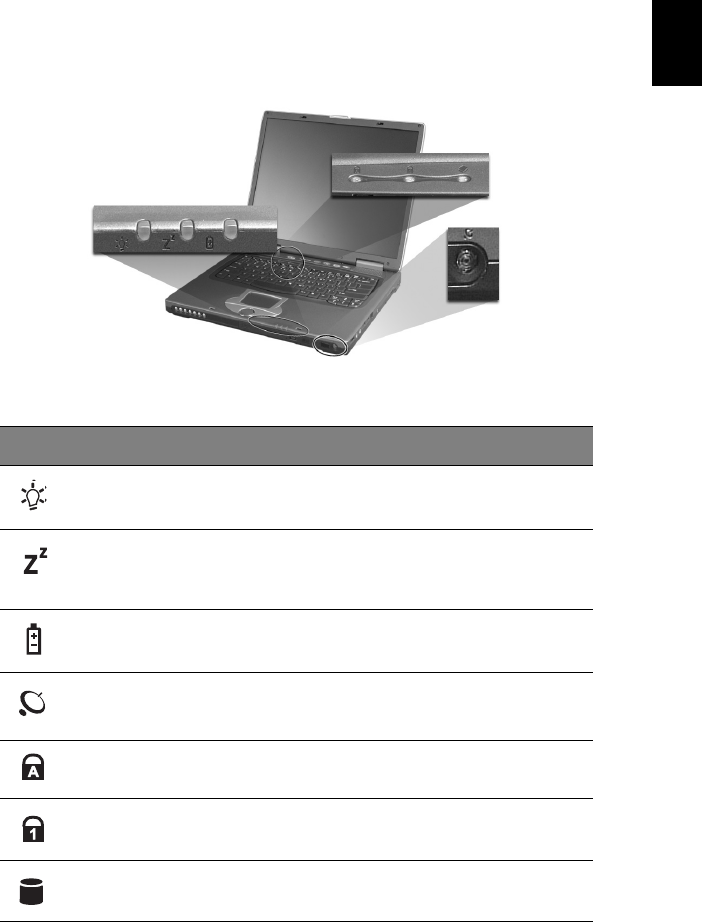
11
English
Indicators
The computer has seven easy-to-read status icons below the display
screen.
Icon Function Description
Power Lights green when the computer is on. Flashes
when the computer is in low power.
Sleep Flashes when the computer is entering Sleep
mode. Lights orange when the computer is in
Sleep mode.
Battery charge Lights when the battery is being charged.
Wireless
communication
Lights when the Wireless LAN or Bluetooth
capabilities are enabled.
Caps lock Lights when Caps Lock is activated.
Num lock Lights when Num Lock is activated.
Media activity Lights when the hard disk or AcerMedia drive
is active.
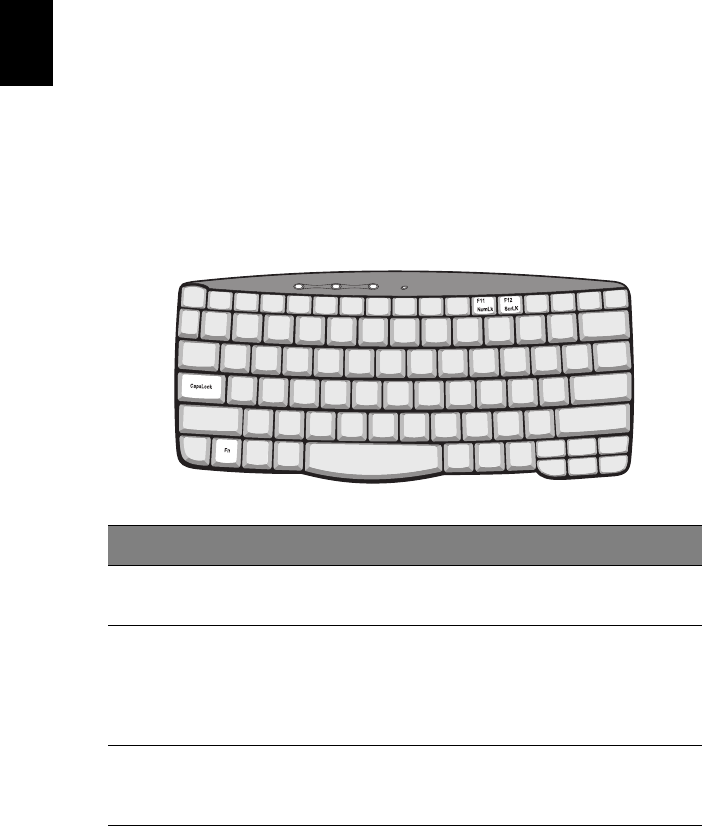
1 Getting to know your TravelMate
12
English
Using the keyboard
The full-sized keyboard includes an embedded numeric keypad,
separate cursor keys, two Windows keys and twelve function keys.
Special keys
Lock keys
The keyboard has three lock keys which you can toggle on and off.
Lock key Description
Caps Lock When Caps Lock is on, all alphabetic characters typed are in
uppercase.
Num Lock
(Fn-F11)
When Num Lock is on, the embedded keypad is in numeric
mode. The keys function as a calculator (complete with the
arithmetic operators +, -, *, and /). Use this mode when you
need to do a lot of numeric data entry. A better solution
would be to connect an external keypad.
Scroll Lock
(Fn-F12)
When Scroll Lock is on, the screen moves one line up or down
when you press the up or down arrow keys respectively.
Scroll Lock does not work with some applications.
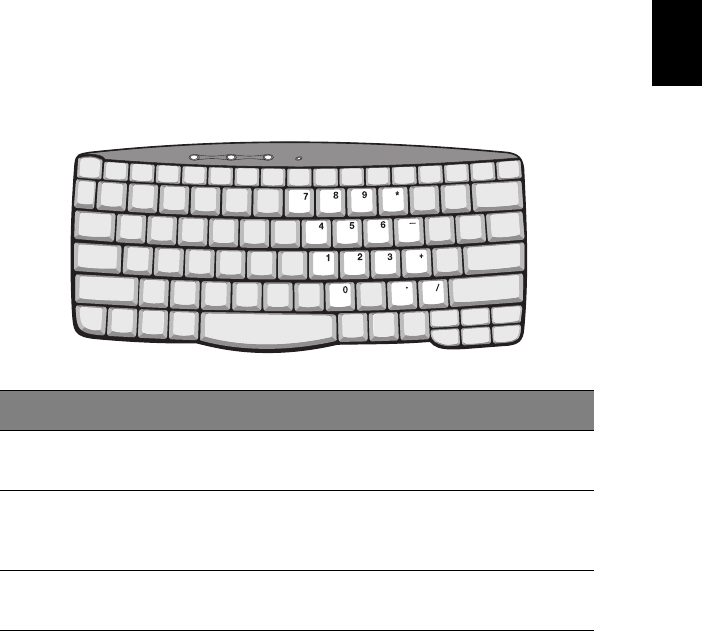
13
English
Embedded numeric keypad
The embedded numeric keypad functions like a desktop numeric
keypad. It is indicated by small characters located on the upper right
corner of the keycaps. To simplify the keyboard legend, cursor-control
key symbols are not printed on the keys.
Desired access Num lock on Num lock off
Number keys on
embedded keypad
Type numbers in a normal
manner.
Cursor-control keys
on embedded
keypad
Hold Shift while using
cursor-control keys.
Hold Fn while using
cursor-control keys.
Main keyboard keys Hold Fn while typing letters
on embedded keypad.
Type the letters in a
normal manner.
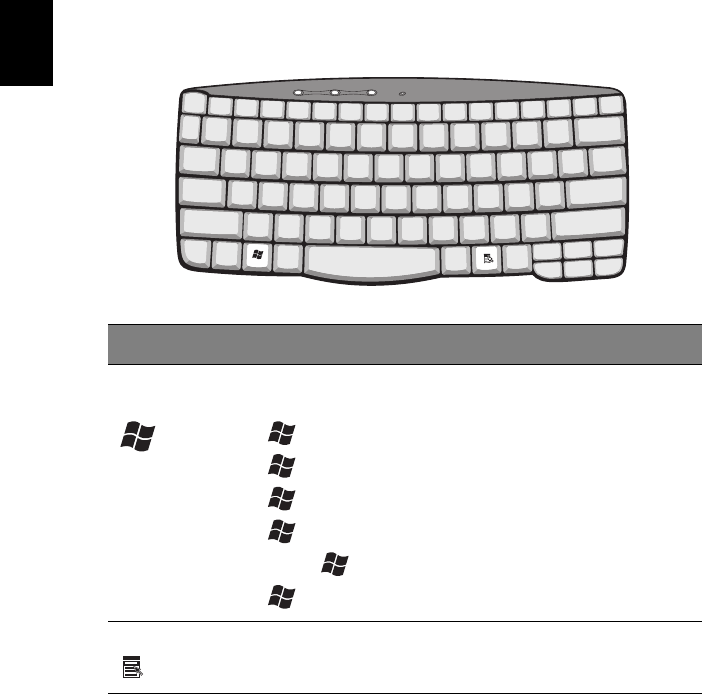
1 Getting to know your TravelMate
14
English
Windows keys
The keyboard has two keys that perform Windows-specific functions.
Key Description
Windows logo
key
Start button. Combinations with this key perform
shortcut functions. Below are a few examples:
+ Tab (Activates next taskbar button)
+ E (Explores My Computer)
+ F (Finds Document)
+ M (Minimizes All)
Shift + + M (Undoes Minimize All)
+ R (Displays the Run... dialog box)
Application key Opens a context menu (same as a right-click).
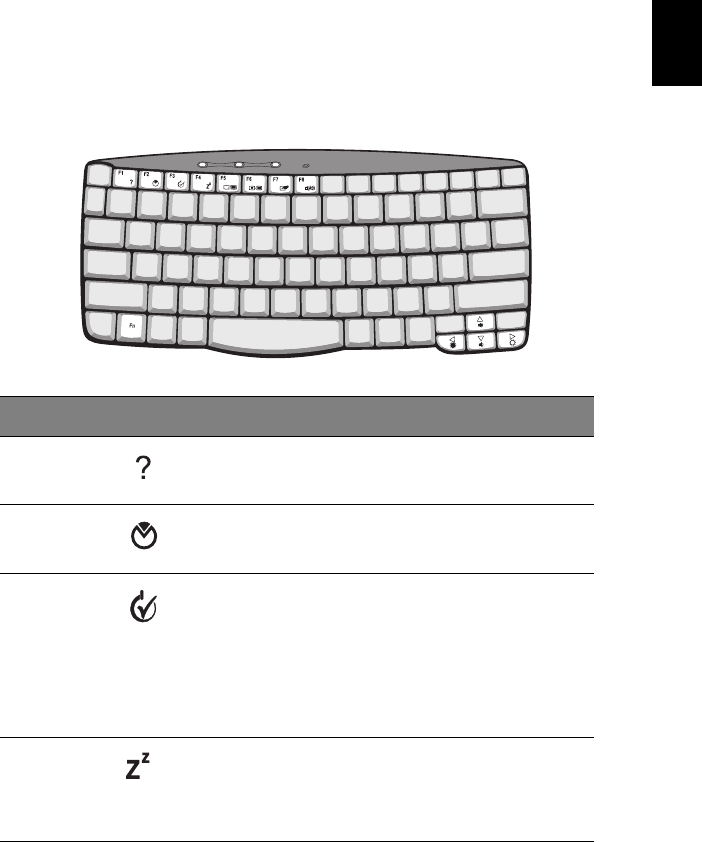
15
English
Hot keys
The computer employs hot keys or key combinations to access most of
the computer’s controls like screen brightness, volume output.
To activate hot keys, press and hold the Fn key before pressing the
other key in the hot key combination.
Hot key Icon Function Description
Fn-F1 Hot key help Displays help on hot keys.
Fn-F2 System Property Displays the System Property.
Fn-F3 Power Options Display the Power Options
Properties used by the
computer (function available
if supported by operating
system).
See “Power management” on
page 26“.
Fn-F4 Sleep Puts the computer in Sleep
mode.
See “Power management” on
page 26“.
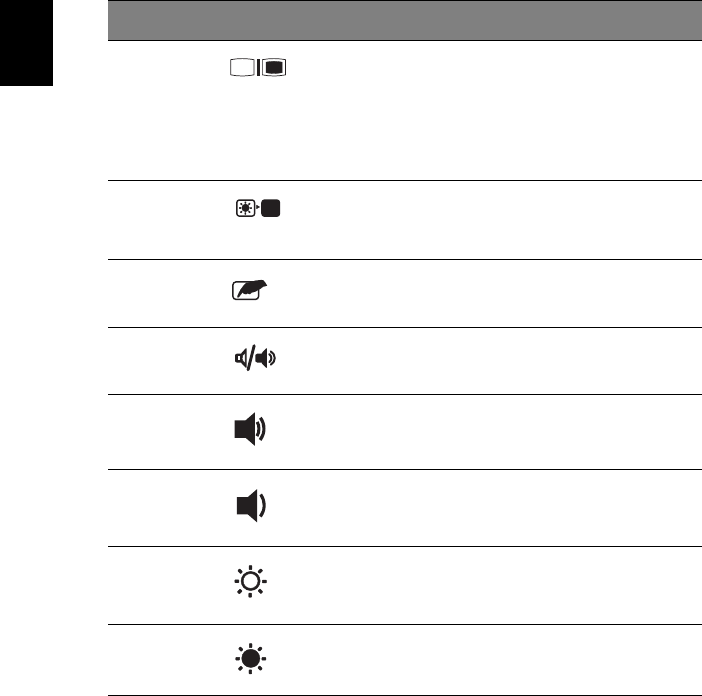
1 Getting to know your TravelMate
16
English
Fn-F5 Display toggle Switches display output
between the display screen,
external monitor (if
connected) and both the
display screen and external
monitor.
Fn-F6 Screen blank Turns the display screen
backlight off to save power.
Press any key to return.
Fn-F7 Touchpad toggle Turns the internal touchpad
on and off.
Fn-F8 Speaker toggle Turns the speakers on and off.
Fn-↑Volume up Increases the speaker volume.
Fn-↓Volume down Decreases the speaker
volume.
Fn-→Brightness up Increases the screen
brightness.
Fn-←Brightness down Decreases the screen
brightness.
Hot key Icon Function Description